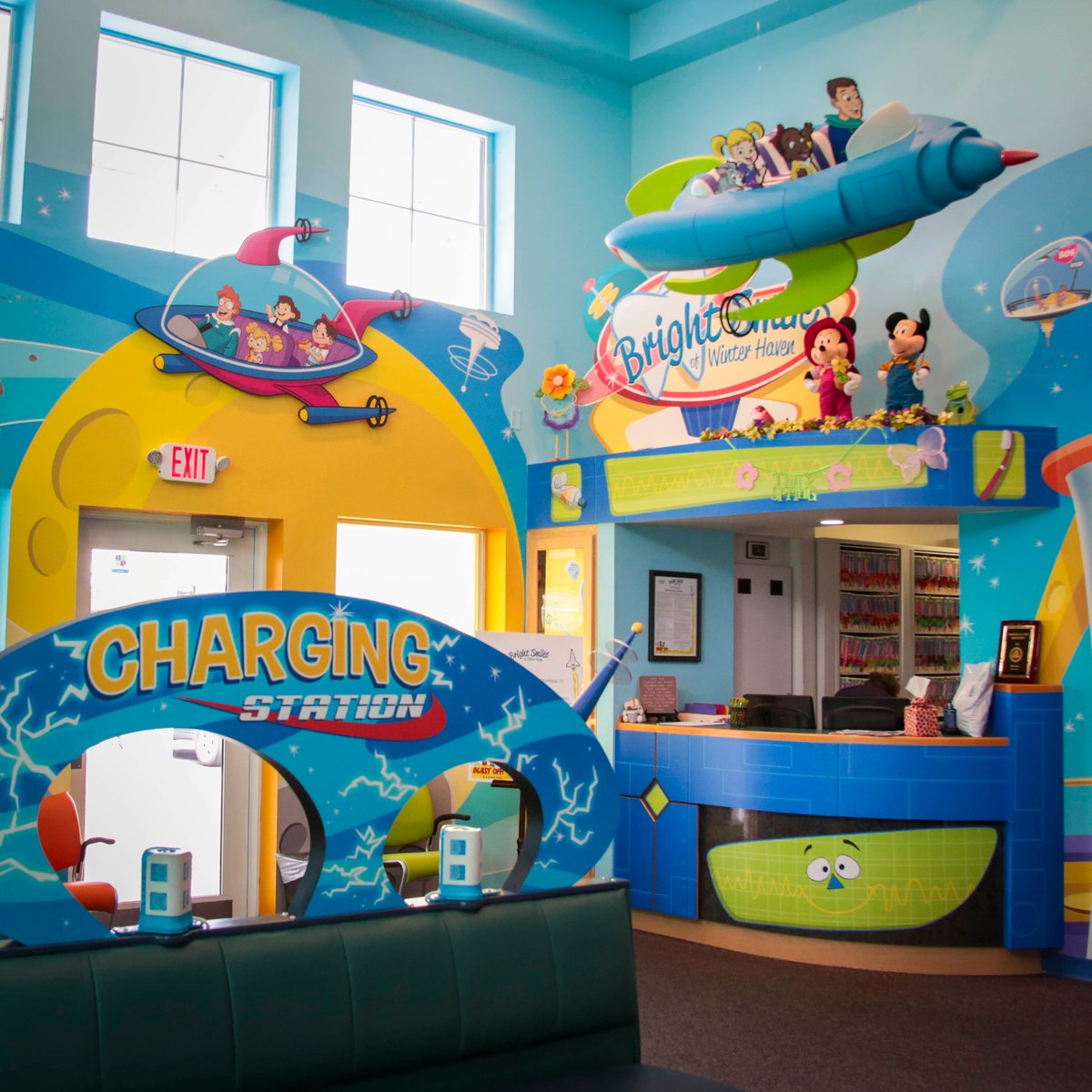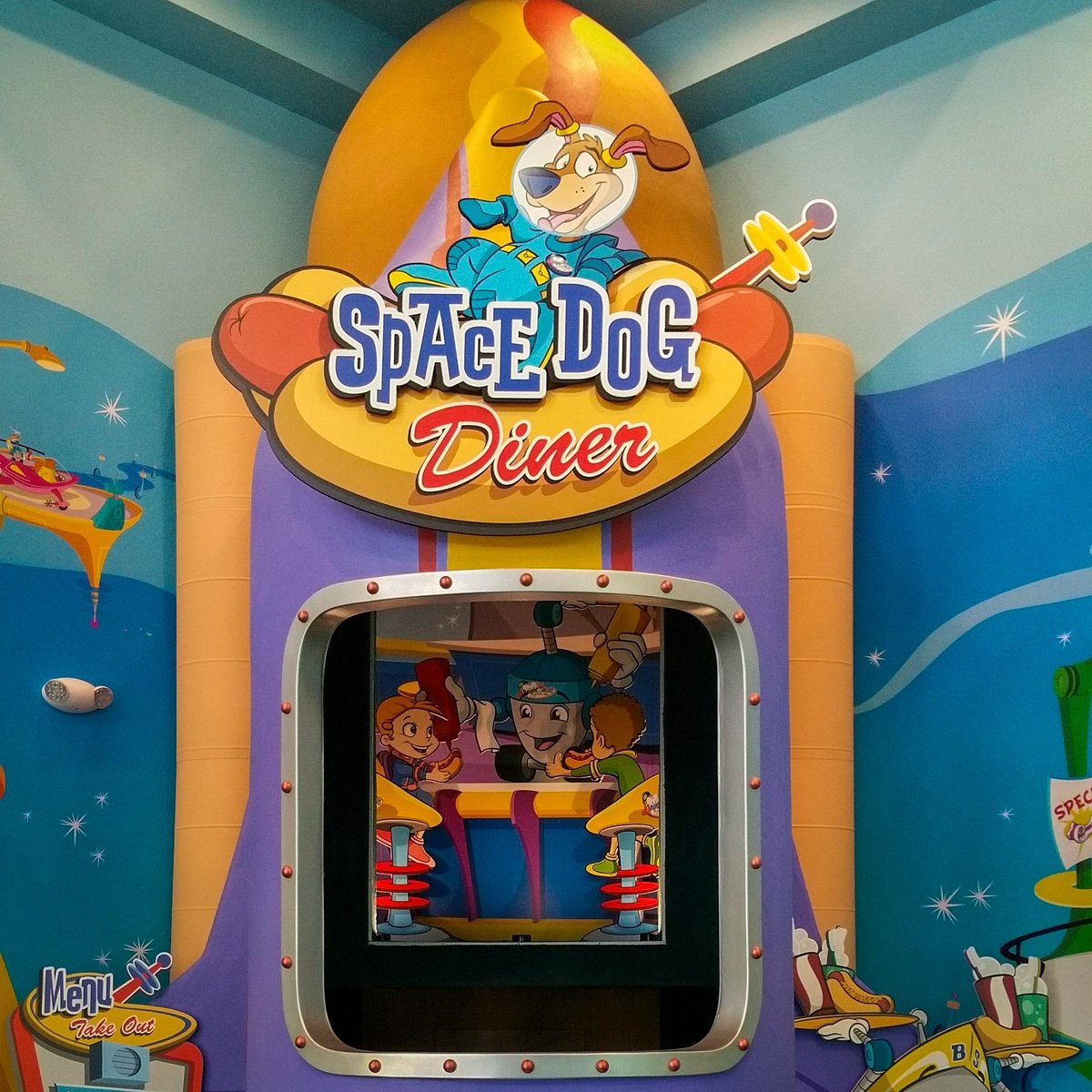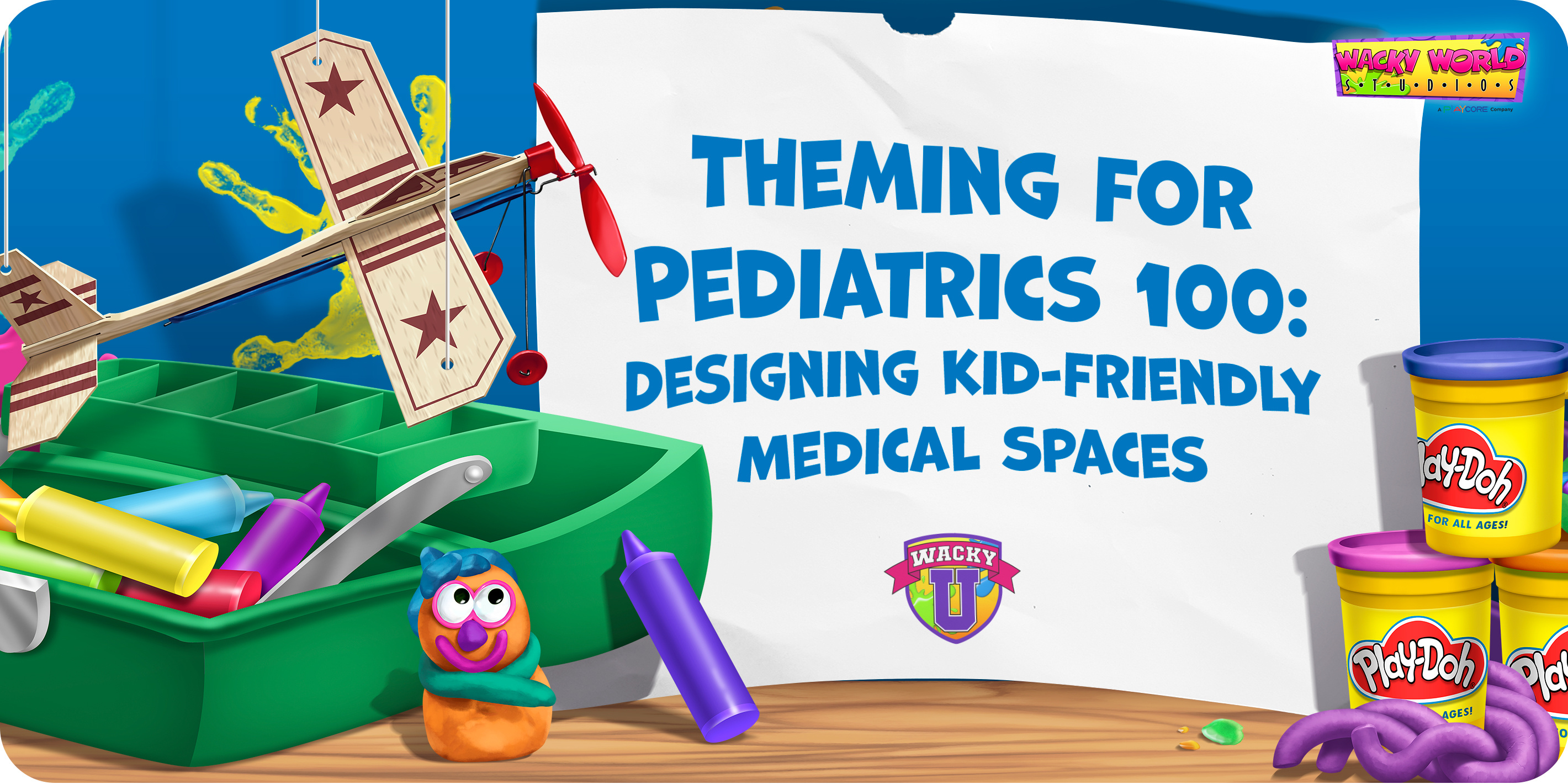Healthcare
Designing Kid-Friendly Medical Spaces
June 17, 2024
When it comes to pediatric healthcare facilities, creating a welcoming, fun, and stress-free environment can make a world of difference for young patients and their families. From hospitals and doctor’s offices to dental practices, theming these spaces can turn a visit into an adventure. Here are some top tips and tricks to help transform a pediatric healthcare facility into an engaging wonderland.
Course Syllabus
- Choose a Kid-Friendly Theme
- Incorporate Interactive Elements and Technology
- Use Bright, Soothing Colors
- Engage All Senses
- Incorporate Educational Themes
- Consider Safety First
- Engage the Senses with Nature
- Personalize the Experience
- Collaborate with Experts
- Final Exam
1. Choose a Kid-Friendly Theme
Start with a theme that resonates with children. Consider options like underwater adventures, jungle safaris, outer space, or enchanted forests. A cohesive theme helps create an immersive experience that can distract and delight young patients. Keep the target age group in mind and aim for themes that are broad enough to appeal to various interests.
When selecting a theme, think about elements that can be easily incorporated into various parts of the facility. For example, an underwater theme can feature fish and coral murals in the waiting area, submarine-style examination rooms, and fish-shaped door handles. A jungle theme can include tree murals, animal footprints leading to different rooms, and leafy decor.
A strong theme helps set the tone for the entire facility. It can guide decisions on color schemes, furniture, decor, and even the types of activities and technology to include. A well-chosen theme can make the environment feel cohesive and thoughtfully designed, providing a more immersive and enjoyable experience for children.
-
 Dr. Jones Orthodontics took their candy factory theme to the next level with all of their thoughtful details...
Dr. Jones Orthodontics took their candy factory theme to the next level with all of their thoughtful details... -
 From the landscaping...
From the landscaping... -
 ...to check-in...
...to check-in... -
 ...to the furniture and decor...
...to the furniture and decor... -
 ...all of the details tied the theme together.
...all of the details tied the theme together.
2. Incorporate Interactive Elements and Technology
Interactive elements are key to engaging children. Integrating activity walls, touch screens with educational games, and interactive murals can keep kids occupied and stimulate their minds, making the environment feel less clinical. These elements can be strategically placed in waiting areas, examination rooms, and even hallways to maintain engagement throughout the visit.
Technology can significantly enhance the themed experience. Projection mapping can create dynamic wall scenes that change over time, turning a plain wall into a scene from an enchanted forest or a bustling cityscape. Interactive screens can provide games and educational content tailored to the theme, while virtual reality experiences can transport children to another world, offering a distraction during medical procedures.
Interactive technology should be intuitive and easy for children to use. Ensure that screens and devices are at an accessible height and that instructions are clear and simple. Regular maintenance and updates are also important to keep these elements functioning smoothly and to introduce new content that keeps the experience fresh and exciting.
-
 Kids Rock Pediatric Dentistry in Colorado built a story around the Tooth Fairy's kidnapping by pirates.
Kids Rock Pediatric Dentistry in Colorado built a story around the Tooth Fairy's kidnapping by pirates. -
.jpg?width=1200&length=1200&name=DrStettlerPedDent_025%20(2).jpg) Kids Rock's interactive games, artwork, and characters immerse kids in the narrative.
Kids Rock's interactive games, artwork, and characters immerse kids in the narrative. -
.jpg?width=1200&length=1200&name=DrStettlerPedDent_061%20(2).jpg)
-

3. Use Bright, Soothing Colors
Colors have a significant impact on mood. Bright, cheerful colors like yellows, reds, and oranges can create a lively atmosphere. However, it's important to avoid overly bright or harsh colors that might overwhelm children. Softer, pastel shades can be soothing and help reduce anxiety, making the environment feel more welcoming.
Incorporate colors that align with your chosen theme. For instance, an outer space theme can use deep blues and purples with splashes of bright stars and planets, while a jungle theme can use lush greens with vibrant pops of colorful flowers and animals. Consistent use of color throughout the facility helps maintain the thematic experience.
The use of color should extend to all aspects of the facility, including walls, furniture, flooring, and decor. By carefully selecting a color palette that enhances the theme, the space can feel more cohesive and thoughtfully designed. This attention to detail can make a significant difference in creating a positive and engaging environment for young patients.
-
 Bright Smiles Pediatric Dentistry chose a retro-futuristic space theme to provide an out-of-this world experience for their young clients.
Bright Smiles Pediatric Dentistry chose a retro-futuristic space theme to provide an out-of-this world experience for their young clients. -
 Cool blue tones and swirling shapes at Bright Smiles create a sense of calm, with pops of yellow and orange for fun and excitement.
Cool blue tones and swirling shapes at Bright Smiles create a sense of calm, with pops of yellow and orange for fun and excitement. -
 Wacky World Studios was even able to incorporate Bright Smiles' Dr. Chang and her family into the artwork at her practice.
Wacky World Studios was even able to incorporate Bright Smiles' Dr. Chang and her family into the artwork at her practice.
4. Engage All Senses
Create a multi-sensory experience by incorporating elements that engage all senses. Soft, playful music in waiting areas, pleasant scents like lavender or vanilla, and tactile surfaces like cushioned seating or textured walls can create a calming and engaging environment. These sensory elements can help distract children from the stress of a healthcare visit.
Think about how each element of the theme can be enhanced through sensory experiences. For an underwater theme, use gentle ocean sounds and the scent of sea breeze to complement the visual decor. For a jungle theme, soft animal noises and the scent of fresh foliage can enhance the immersive experience, making the environment more enjoyable for children.
Sensory elements should be subtle and not overwhelming. Ensure that scents are not too strong and that sounds are kept at a comfortable volume. The goal is to create a balanced sensory environment that enhances the thematic experience without causing sensory overload for the children.
-
 Muted colors and ocean sounds create a relaxing atmosphere in Celebration Health Hospital's MRI scan rooms in Orlando, FL.
Muted colors and ocean sounds create a relaxing atmosphere in Celebration Health Hospital's MRI scan rooms in Orlando, FL. -
 Soft lighting adds to the relaxing beach feel at Celebration Health.
Soft lighting adds to the relaxing beach feel at Celebration Health.
5. Incorporate Educational Themes
Blend fun with learning by incorporating educational themes. Use wall art, posters, and interactive displays to share fun facts about animals, space, or nature. This not only entertains but also helps children learn something new during their visit, making the time spent in the facility more enriching.
Educational elements can be seamlessly integrated into the theme. For instance, an enchanted forest theme can include information about different types of trees and animals found in forests, while an outer space theme can feature facts about planets, stars, and space exploration. These educational touches provide both entertainment and learning opportunities.
Creating educational opportunities can also involve interactive technology. Touch screens with educational games or virtual reality experiences can provide fun, immersive learning experiences that align with the theme. This approach not only keeps children engaged but also adds value to their time spent in the facility.
-
 Simple reminders like "Wash your hands!" and "Brush and floss" are displayed in fun graphics at The Smile Shoppe in Rogers, Arkansas.
Simple reminders like "Wash your hands!" and "Brush and floss" are displayed in fun graphics at The Smile Shoppe in Rogers, Arkansas.
6. Consider Safety First
Safety should always be a top priority. Ensure that all decorations, furniture, and interactive elements are safe for children. Avoid sharp edges, small detachable parts, and materials that could cause allergies. Regularly inspect and maintain themed elements to ensure they remain safe and in good condition.
Childproofing the facility involves more than just selecting safe materials. Furniture should be sturdy and stable, with no risk of tipping over. Decorations should be securely fastened to walls or ceilings to prevent accidents. Additionally, ensure that all interactive elements, such as screens and activity walls, are designed to withstand frequent use by energetic children.
Regular maintenance checks are crucial to ensure that all elements remain in good working order. Broken or worn-out items should be repaired or replaced promptly. By prioritizing safety, the facility can provide a fun and engaging environment without compromising the well-being of its young patients.
7. Engage the Senses with Nature
Incorporate elements of nature to create a calming environment. Use potted plants, nature-themed murals, and even aquariums to bring the outdoors inside. Nature has a soothing effect and can help reduce stress and anxiety in children, making their visit to the healthcare facility more pleasant.
Natural elements can be a part of any theme. For example, an enchanted forest theme can include real plants and small trees, while an underwater theme can feature aquariums with colorful fish. These touches of nature can make the environment feel more welcoming and less clinical, providing a sense of calm and tranquility.
Integrating nature into the design can also involve using natural materials such as wood and stone in furniture and decor. These materials can add warmth and texture to the space, enhancing the overall thematic experience. By incorporating natural elements, the facility can create a more holistic and soothing environment for young patients.
-
 Kids Dentistry of North Georgia brought the outdoors inside with a colorful mural featuring a friendly backyard treehouse theme and 2D relief branches.
Kids Dentistry of North Georgia brought the outdoors inside with a colorful mural featuring a friendly backyard treehouse theme and 2D relief branches. -
 Kids' Dentistry enhanced the treehouse theme with bare wood planks and exposed beams.
Kids' Dentistry enhanced the treehouse theme with bare wood planks and exposed beams. -
 Consistent theming from check-in to exam rooms creates a fun experience for all.
Consistent theming from check-in to exam rooms creates a fun experience for all.
8. Personalize the Experience
Add personal touches to make each visit special. Use name tags, personalized greetings, and even themed stickers or small gifts related to the theme. Personalized experiences can make children feel valued and cared for, turning a routine visit into a memorable adventure.
Consider creating themed welcome packages for new patients, including items like stickers, coloring books, and small toys that align with the theme. Personalized greetings from staff members can also help children feel more comfortable and welcomed, reducing anxiety and making the visit more enjoyable.
Personalization can extend to the decor as well. Displaying patient artwork or featuring stories and photos of past patients (with permission) can create a sense of community and belonging. These personal touches can make the healthcare facility feel more like a supportive, friendly space rather than a sterile, clinical environment.
9. Collaborate with Experts
Collaborate with designers, artists, and child psychologists to create an environment that is not only fun but also developmentally appropriate and psychologically beneficial. Experts can provide valuable insights into what works best for children in a healthcare setting, ensuring that the themed environment is both engaging and supportive of their needs.
A professional theming company, such as Wacky World Studios, with its wealth of experience in creating immersive themed environments, will be able to design spaces that are both visually appealing and beneficial for children's emotional and psychological well-being. This collaboration ensures that the themed elements are not only entertaining but also supportive of children's developmental needs.
By involving experts in the design process, the facility can create a more holistic and effective environment. Child psychologists can offer insights into what helps reduce anxiety and promote positive experiences, while designers and artists can bring the theme to life in creative and engaging ways. This multidisciplinary approach ensures that the themed environment is both fun and functional.
Creating a themed pediatric healthcare facility requires a blend of creativity, practicality, and a deep understanding of what makes children tick. With these tips and tricks, transforming a healthcare environment into a place of wonder and comfort can make a significant difference in the lives of young patients and their families.
Stay in the know with Wacky World Studios! We're here to help you with all stages of your theming journey. Make sure you sign up for our monthly newsletter and subscribe to this blog for even more handy theming resources and information. You can also get lots of great inspiration when you follow us on social. Our Pinterest and Instagram pages are overflowing with photos and ideas.
Ready to test your knowledge?
Subscribe here for Wacky U updates!
And for you DIYers, be sure to check out our online shop at WackyWorldDIY.com.


